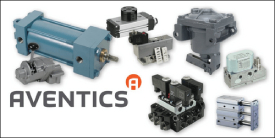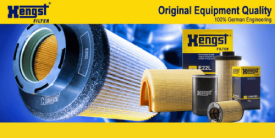PRESSURE RELIEF VALVE DBDA 10 K1X/50
Manufacturer: Bosch Rexroth
Material #: R900425966
Model : DBDA 10 K1X/50
***Disclaimer: The following summary contains information gathered from various sources such as product descriptions, technical specifications and catalogs. While efforts have been made to provide accurate details, inaccuracies may occur. It is advised to verify all information by contacting Bosch Rexroth directly.***
The Bosch Rexroth DBDA 10 K1X/50 (R900425966) is a high-quality screw-in cartridge valve designed for use in hydraulic systems. This direct operated pressure relief valve is part of the DBD.K product family, which is classified under pressure relief valves. It has a maximum operating pressure of 350 bar (5076 psi) and can handle a maximum flow of 50 l/min (13.2 gpm). The valve features a cavity designated as Mx, and it utilizes NBR as its sealing material.
The DBDA 10 K1X/50 model is equipped with a poppet type spool for efficient fluid control and comes with various adjustment options including a lockable rotary knob, providing users with precise control over system pressure settings. The valve operates by using a spring mechanism to hold the poppet against its seat until the system pressure exceeds the set value, at which point the poppet lifts to allow fluid to pass from channel P to T, thereby relieving excess pressure.
This specific model has been engineered for versatility with G 3/8 ports and can be installed as a screw-in cartridge valve or mounted on a subplate. Its robust design ensures reliable operation in diverse hydraulic applications that require direct acting relief function. The DBDA 10 K1X/50 is an integral component for maintaining stable system pressures and protecting hydraulic circuits from potential overpressure damage.
In terms of maintenance and adjustments, Bosch Rexroth has designed this valve with user-friendly features such as an adjustment element that remains movable even when completely unloaded, ensuring ease of setting and re-setting system pressures as needed. The product's size and component series X designation signify its capability to withstand demanding operational conditions up to its maximum rated pressure.
$562.00 USD
More are expected on June 29, 2026
| Qty | Price | Savings |
|---|---|---|
| 5-24 | $547.95 USD | $14.05 USD |
| 25+ | $533.90 USD | $28.10 USD |
Status: This product is temporarily out of stock.
Qty: Delivered as early as June 29, 2026 when ordered in
This product is eligible for factory repair.
Unpacked Weight: 0.637501 kg
As screw-in cartridge valve (cartridge) For threaded connection For subplate mounting Adjustment type for pressure adjustment, optionally:
‒ Sleeve with hexagon and protective cap
‒ Rotary knob
‒ Hand wheel
‒ Lockable rotary knob
Pressure relief valves of type DBD are direct operated seat valves. They are used for limiting a system pressure.
The valves basically consist of sleeve (1), spring (2), poppet with damping piston (3) (pressure rating 25 bar … 400 bar) or ball (4) (pressure rating 630 bar) and adjustment type (5). The system pressure can be set steplessly via the adjustment type (5). The spring (2) pushes the poppet (3) or the ball (4) onto the seat. Channel P is connected to the system. The pressure existing in the system acts on the poppet surface (or the ball). If the pressure in channel P exceeds the value set at the spring (2), the poppet (3) or the ball (4) opens against the spring (2). Now, hydraulic fluid from channel P flows into channel T. The stroke of the poppet (3) is limited by the embossing (6).
In order to achieve good pressure adjustment over the entire pressure range, the entire pressure range has been divided into 7 pressure ratings. One pressure rating corresponds to a certain spring for a maximum operating pressure that can be set by means of that spring.
Type DBDS..K1X/…
Version pressure rating 25 … 400 bar (poppet seat valve)

Type DBDH 10 K1X/…
Version pressure rating 630 bar (ball seat valve, only NG10)


Notices:
The adjustment type (5) is constructed so that it cannot be lost. Due to the gimbal-mounting, the adjustment element remains loose (movable) in the adjustment type (5) in case of complete unloading. Pressure rating “25”: If despite completely unloaded adjustment type, the minimum pressure does not settle, the adjustment element has to be “pulled back” to the stop due to the low spring and/or restoring force. For pressure adjustment / increase, the adjustment element can then be screwed in again.| Screw-in cartridge valve |
| Maximum operating pressure 630 bar (9150 psi) |
| Maximum flow 120 l/min (32 gpm) |
| Cavity M35x1,5 |
| Data Sheet | Download Data Sheet |
| Product family classification | Pressure relief valve, direct operated |
| Connection diagram | Mounting cavity type DBD NG10 |
| Product family type | DBD.K |
| Max. pressure | 630 |
| Ports number | 2 |
| Max. flow | 120 |
| Spool Poppet | Poppet type |
| Type of connection | Screw-in cartridge valve |
| Direct - Pilot | Direct acting |
| Cavity | M35x1,5 |
| Nominal flow | 120 |
| Adjustment options | Lockable rotary knob |
| Ports | G 1/2 |
| Sealing material | NBR |
| Hydraulic fluid | HL,HLP,HLPD,HVLP,HVLPD,HFC |
| Productgroup ID | 9,10,11,12,13,14 |
| Product type | DBD.K |
| Product family | Relief |
| Weight | 0.637501 |
|
01 |
02 |
03 |
04 |
05 |
06 |
07 |
08 |
09 |
10 |
|
|
DBD |
1X |
/ |
* |
|
01 |
Pressure relief valve, direct controlled |
DBD |
|||||||
|
Adjustment type for pressure adjustment |
|||||||||
|
02 |
NG6 |
NG8 |
NG10 |
NG15 |
NG20 |
NG25 |
NG30 |
||
|
Sleeve with hexagon and protective cap |
✔ |
✔ |
✔ |
✔ |
✔ |
✔ |
✔ |
S |
|
|
Rotary knob 1) |
✔ |
✔ |
✔ |
✔ |
✔ |
– |
– |
H |
|
|
Hand wheel 2) |
– |
– |
– |
– |
– |
✔ |
✔ |
H |
|
|
Lockable rotary knob 1,3,4) |
✔ |
✔ |
✔ |
✔ |
✔ |
– |
– |
A |
|
|
03 |
Size 6 (connection G1/4) |
6 |
|||||||
|
Size 8 (connection G3/8) |
8 |
||||||||
|
Size 10 (connection G1/2) |
10 |
||||||||
|
Size 15 (connection G3/4) |
15 |
||||||||
|
Size 20 (connection G1) |
20 |
||||||||
|
Size 25 (connection G1 1/4) |
25 |
||||||||
|
Size 30 (connection G1 1/2) |
30 |
||||||||
|
Type of connection |
|||||||||
|
04 |
NG6 |
NG8 |
NG10 |
NG15 |
NG20 |
NG25 |
NG30 |
||
|
As screw-in cartridge valve (cartridge) |
✔ |
– |
✔ |
– |
✔ |
– |
✔ |
K |
|
|
For threaded connection 5) |
✔ |
✔ |
✔ |
✔ |
✔ |
✔ |
✔ |
G |
|
|
For subplate mounting |
✔ |
– |
✔ |
– |
✔ |
– |
✔ |
P |
|
|
05 |
Component series 10 ... 1Z (10 ... 1Z: unchanged installation and connection dimensions) |
1X |
|||||||
|
Pressure rating 6) |
|||||||||
|
06 |
NG6 |
NG8 |
NG10 |
NG15 |
NG20 |
NG25 |
NG30 |
||
|
Set pressure up to 25 bar |
✔ |
✔ |
✔ |
✔ |
✔ |
✔ |
✔ |
25 |
|
|
Set pressure up to 50 bar |
✔ |
✔ |
✔ |
✔ |
✔ |
✔ |
✔ |
50 |
|
|
Set pressure up to 100 bar |
✔ |
✔ |
✔ |
✔ |
✔ |
✔ |
✔ |
100 |
|
|
Set pressure up to 200 bar |
✔ |
✔ |
✔ |
✔ |
✔ |
✔ |
✔ |
200 |
|
|
Set pressure up to 315 bar |
✔ |
✔ |
✔ |
✔ |
✔ |
✔ |
✔ |
315 |
|
|
Set pressure up to 400 bar |
✔ |
✔ |
✔ |
✔ |
✔ |
– |
– |
400 |
|
|
Set pressure up to 630 bar 7) |
– |
– |
✔ |
– |
– |
– |
– |
630 |
|
|
Seal material |
|||||||||
|
07 |
NBR seals |
no code |
|||||||
|
FKM seals |
V |
||||||||
|
Observe compatibility of seals with hydraulic fluid used. (Other seals upon request) |
|||||||||
|
Line connection |
|||||||||
|
08 |
Pipe thread according to ISO 228/1 |
no code |
|||||||
|
SAE thread |
12 |
||||||||
|
Equipment Directive |
|||||||||
|
09 |
Without type-examination procedure |
no code |
|||||||
|
Type-examination tested safety valve according to Pressure Equipment Directive 2014/68/EU |
E |
||||||||
|
10 |
Further details in the plain text |
||||||||
| 1) | With size 20, only available for the pressure ratings "25", "50" or "100". |
| 2) | Only available for the pressure ratings "25", "50" or "100". |
| 3) | Key with material no. R900008158 is included in the scope of delivery. |
| 4) | Not available for type-examination tested safety valves. |
| 5) | Not available for type-examination tested safety valves of size 8, 15 and 25. |
| 6) | When selecting the pressure rating, please observe the characteristic curves. |
| 7) | With version "G" and "P", only available as "SO292", see "dimensions". |
Type-examination tested safety valves type DBD
(Component series 1X according to the Pressure Equipment Directive 2014/68/EU)
|
NG |
Type designation |
Component marking |
|
6 |
DBDS 6 K1X /▢ E |
TÜV.SV. "xxx" –849.5.F.αw.p TÜV.SV. "xxx" –849.5.F.G.p |
|
DBDH 6 K1X /▢ E |
||
|
DBDS 6 G1X /▢ E |
||
|
DBDH 6 G1X /▢ E |
||
|
DBDS 6 P1X /▢ E |
||
|
DBDH 6 P1X /▢ E |
||
|
10 |
DBDS 10 K1X /▢ E |
TÜV.SV. "xxx" –850.6.F.αw.p. TÜV.SV. "xxx" –850.6.F.G.p. TÜV.SV. "xxx" –390.4,5.F.30.p. 1) |
|
DBDH 10 K1X /▢ E |
||
|
DBDS 10 G1X /▢ E |
||
|
DBDH 10 G1X /▢ E |
||
|
DBDS 10 P1X /▢ E |
||
|
DBDH 10 P1X /▢ E |
||
|
20 |
DBDS 20 K1X /▢ E |
TÜV.SV. "xxx" –361.10.F.αw.p. |
|
DBDH 20 K1X /▢ E |
||
|
DBDS 20 G1X /▢ E |
||
|
DBDH 20 G1X /▢ E |
||
|
DBDS 20 P1X /▢ E |
||
|
DBDH 20 P1X /▢ E |
||
|
30 |
DBDS 30 K1X /▢ E |
TÜV.SV. "xxx" –362.15.F.αw.p. |
|
DBDH 30 K1X /▢ E |
||
|
DBDS 30 G1X /▢ E |
||
|
DBDH 30 G1X /▢ E |
||
|
DBDS 30 P1X /▢ E |
||
|
DBDH 30 P1X /▢ E |
| 1) | Component marking for DBD. 10.1X/...; 400 bar < p ≤ 630 bar |
|
▢ |
In the type designation, the pressure is to be entered by the customer; Pressure adjustment ≥ [si]30 bar [/si][imp]435 psi[/imp] and possible in 5 bar [/si][imp]75 psi[/imp] steps. |
|
"xxx" |
Value entered at the factory |
For applications outside these parameters, please consult us!
general
|
Size |
6 | 8 | 10 | 15 | 20 | 25 | 30 | ||
|
Weight |
See dimensions | ||||||||
|
Installation position |
any | ||||||||
|
Ambient temperature range |
NBR seals |
°C |
-30 … +80 | ||||||
|
FKM seals |
°C |
-15 … +80 | |||||||
|
Minimum stability of the housing materials |
Housing materials are to be selected so that there is sufficient safety for all imaginable operating conditions (e.g. with regard to pressure resistance, thread stripping strengths and tightening torques). | ||||||||
hydraulic
|
Size |
6 | 8 | 10 | 15 | 20 | 25 | 30 | ||
|
Maximum operating pressure |
Inlet |
bar |
400 | 630 | 400 | 315 | |||
|
Outlet |
bar |
315 | |||||||
|
Maximum flow (standard valves) |
See characteristic curves | ||||||||
|
Hydraulic fluid |
see table | ||||||||
|
Hydraulic fluid temperature range |
NBR seals |
°C |
-30 … +80 | ||||||
|
FKM seals |
°C |
-15 … +80 | |||||||
|
Viscosity range |
mm²/s |
10 … 800 | |||||||
|
Maximum admissible degree of contamination of the hydraulic fluid 1) |
Class 20/18/15 according to ISO 4406 (c) | ||||||||
| 1) | The cleanliness classes specified for the components must be adhered to in hydraulic systems. Effective filtration prevents faults and simultaneously increases the life cycle of the components. For the selection of the filters, see www.boschrexroth.com/filter. |
|
Hydraulic fluid |
Classification |
Suitable sealing materials |
Standards |
Data sheet |
|
|
Mineral oils |
HL, HLP, HLPD, HVLP, HVLPD |
NBR, FKM |
DIN 51524 |
90220 |
|
|
Bio-degradable |
Insoluble in water |
HETG |
NBR, FKM |
ISO 15380 |
90221 |
|
HEEG |
FKM |
||||
|
Soluble in water |
HEPG |
FKM |
ISO 15380 |
||
|
Important information on hydraulic fluids: For further information and data on the use of other hydraulic fluids, please refer to the data sheets above or contact us. There may be limitations regarding the technical valve data (temperature, pressure range, life cycle, maintenance intervals, etc.). The ignition temperature of the hydraulic fluid used must be 50 K higher than the maximum surface temperature. Bio-degradable and flame-resistant: If this hydraulic fluid is used, small amounts of dissolved zinc may get into the hydraulic system. |
|||||
Notice:
Hydraulic counter pressures in port T add 1:1 to the response pressure of the valve set at the adjustment type.
Example:
Pressure adjustment of the valve due to spring pretensioning (see "Product description" item 2) pspring = 200 bar Hydraulic counter pressure in port T: phydraulic = 50 bar ⇒ Response pressure = pspring + phydraulic = 250 barDeviating technical data: Type-examination tested safety valves type DBD
(Component series 1X, according to Pressure Equipment Directive 2014/68/EU)
general
|
Ambient temperature range |
°C |
-10 … +80 |
hydraulic
|
Set response pressure |
see last figure of the component marking | |
|
Maximum counter pressure in the discharge line |
See characteristic curves "Counter pressure in the discharge line” | |
|
Maximum flow |
The last but one figure of the component marking attached at the safety valve is always binding. For valve types which have a variable maximum flow depending on the response pressure, the discharge coefficient is specified at this place. | |
|
Hydraulic fluid |
Hydraulic fluids according to DIN 51524: Hydraulic oils HL and HLP are suitable for safety valves with NBR or FKM seals. | |
|
Hydraulic fluid temperature range |
-10 … +60 °C | |
|
Viscosity range |
12 … 230 mm²/s |
(measured with HLP46, ϑOil = 40 ±5 °C)
Size 6
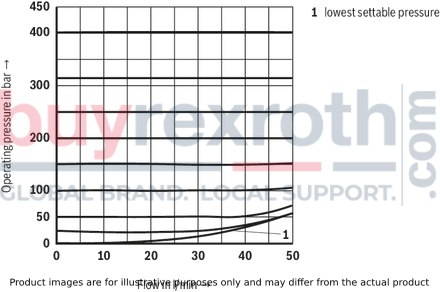
Size 8 and 10
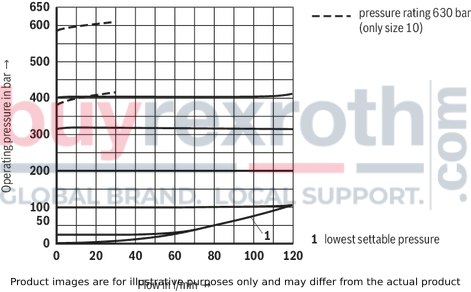
Size 15 and 20
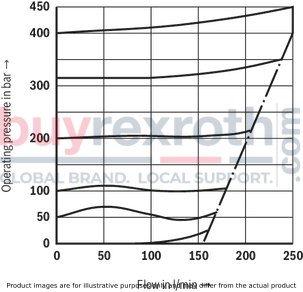
Size 25 and 30

Notices:
The characteristic curves apply to the pressure at the valve output p = 0 bar across the entire flow range. The characteristic curves only apply with the specified environmental and temperature conditions. It has to be noted that the development of the characteristic curve will be influenced in case of deviating boundary conditions. The characteristic curves refer to the specified pressure ratings (e.g. 200 bar ). The more the set pressure value differs from the nominal pressure rating (e.g. < 200 bar), the larger the pressure increase with increasing flow gets.Type-examination tested safety valves type DBD
(Component series 1X, according to Pressure Equipment Directive 2014/68/EU) (dimensions in mm)
Size 6
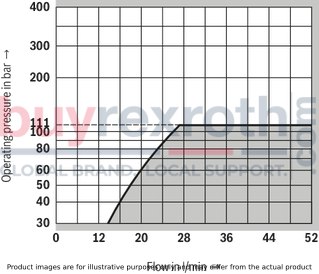
Size 10
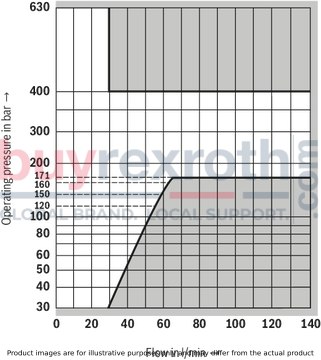
Size 20
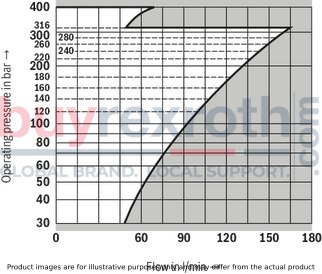
Size 30
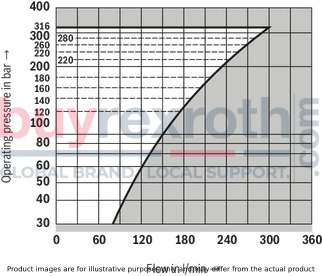
Notice:
Value pairs located in the areas of the characteristic curves with gray background can not be realized with the safety valve. The characteristic curves shown here are only valid for a counter pressure of 0 bar in the discharge line.
Counter pressure in the discharge line
Basically, the valve should be operated without counter pressure in the discharge line, if possible. With counter pressure in the discharge line, the maximum flow possible is reduced. There is a relation between the maximum counter pressure pT in the discharge line and flow qV, which can be seen from the following characteristic curves. Characteristic curves for intermediate values of the response pressure which are not listed must be determined by means of interpolation.
With a flow approaching zero, the maximum counter pressure pT is in each case 10 % of the response pressure. With increasing flow, the maximum counter pressure pT is reduced.
Interpolation of intermediate values from the diagram
At the pT axis, mark 1/10 of the value of pA. Determine the next lower and the next higher characteristic curve for this point. The point marked at pT divides the section between lower and higher characteristic curve on the pT axis with a certain percentage. At the qVmax axis, divide the section between next lower and next higher characteristic curve in the same percentage as the section at the pT axis. From the zerocrossing on the qVmax axis determined in that way, draw a straight line to the value on the pT axis marked before. Mark the system flow to be secured at the qVmax axis. Read off the maximum counter pressure for this value using the line at the pT axis drawn before.
Determination of the maximum counter pressure
Example 1 (with already existing characteristic curve):
Flow of the system / accumulator to be secured: qVmax = 115 l/min Safety valve set to: pA = 315 bar. Read off the maximum counter pressure pT of approx. 22,5 bar from the diagram (see arrows, Size 6, characteristic curve 7).
Example 2 (with interpolated characteristic curve):
Flow of the system / accumulator to be secured: qVmax = 15 l/min Safety valve set to: pA = 80 bar. Value to be marked at the axis referred to as pT: 1/10 x 80 bar = 8 bar. Read off the maximum counter pressure pT of approx. 3 bar from the diagram (see arrows, dashed characteristic curve).Size 6
Diagram for determining the maximum counter pressure pT in the discharge line at port T of the valve dependent on the flow qVmax for valves type DBD... with different response pressures pA.Intermediate values may be determined by means of interpolation. Regarding the procedure for interpolation refer to "Interpolation of intermediate values from the diagram".
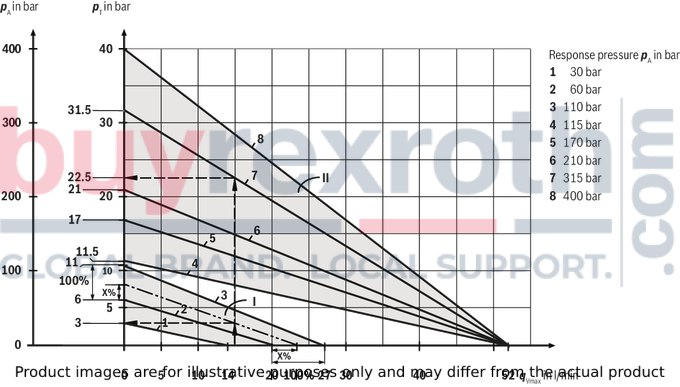
|
pA |
Response pressure in bar |
|
pT |
Maximum counter pressure in the discharge line (port T) in bar |
|
qVmax |
Maximum flow in l/min |
|
▢ | |
Interpolation area |, for valves with response pressure pA = 30 ... 110 bar and maximum flow qVmax = 14 ... 27 l/min |
|
▢ ‖ |
Interpolation area ‖, for valves with response pressure pA = 115 ... 400 bar and maximum flow qVmax = 52 l/min |
Size 10
Diagram for determining the maximum counter pressure pT in the discharge line at port T of the valve dependent on the flow qVmax for valves type DBD... with different response pressures pA.Intermediate values may be determined by means of interpolation. Regarding the procedure for interpolation refer to "Interpolation of intermediate values from the diagram".
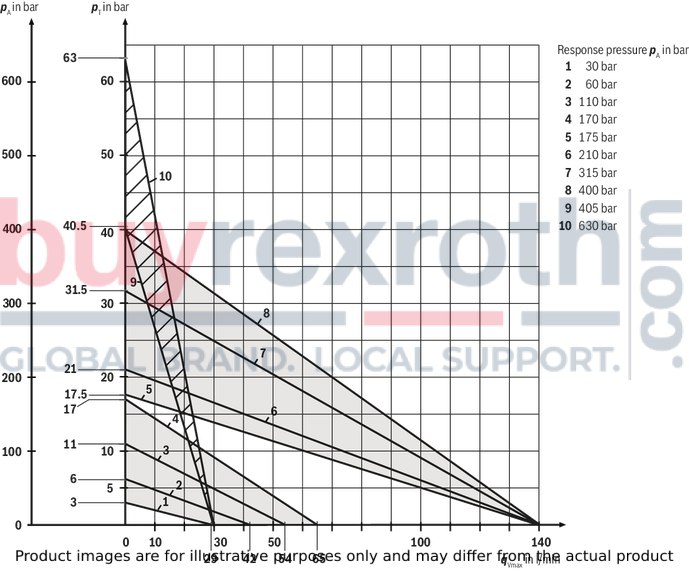
|
pA |
Response pressure in bar |
|
pT |
Maximum counter pressure in the discharge line (port T) in bar |
|
qVmax |
Maximum flow in l/min |
|
▢ ▢ |
Interpolation areas |
Size 20
Diagram for determining the maximum counter pressure pT in the discharge line at port T of the valve dependent on the flow qVmax for valves type DBD... with different response pressures pA.Intermediate values may be determined by means of interpolation. Regarding the procedure for interpolation refer to "Interpolation of intermediate values from the diagram".
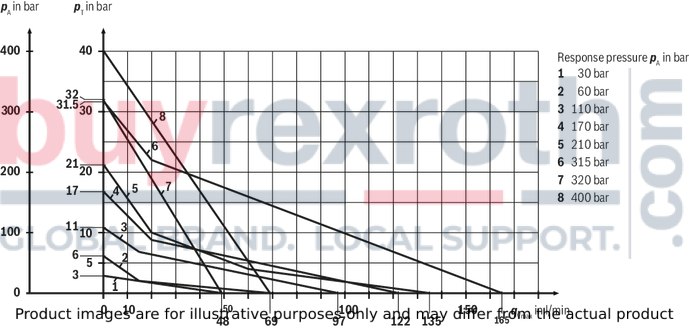
Size 30
Diagram for determining the maximum counter pressure pT in the discharge line at port T of the valve dependent on the flow qVmax for valves type DBD... with different response pressures pA.Intermediate values may be determined by means of interpolation. Regarding the procedure for interpolation refer to "Interpolation of intermediate values from the diagram".
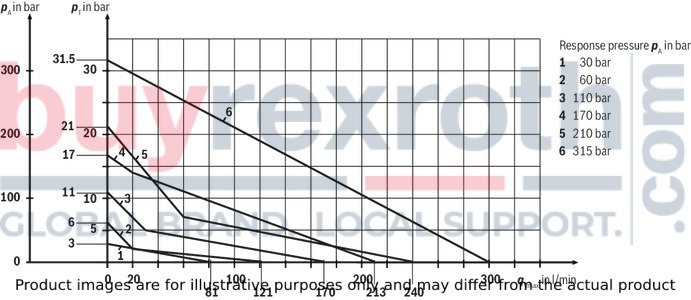
Threaded connection "G"
(dimensions in mm)
Dimensions in mm
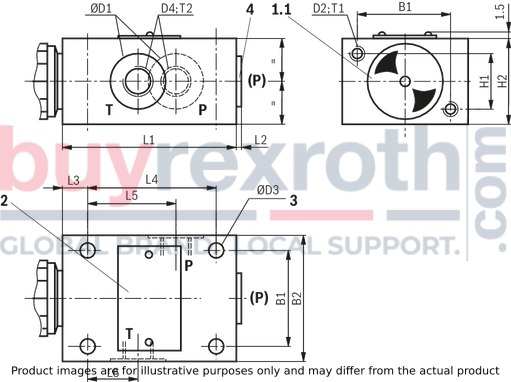
|
1.1 |
Adjustment type "S” (example) Grub screw with hexagon and protective cap; Internal hexagon (NG6 … NG20) External hexagon (NG25 and 30) |
|
2 |
Name plate |
|
3 |
4 valve mounting bores |
|
4 |
Additional port (P), optional (e.g. for pressure measurement); not possible for NG10 and pressure rating > 400 bar (= version “SO292”). Dimensions see dimensions D4, tightening torque see table. |
|
NG |
B1 |
B2 |
ØD1 |
D2 |
ØD3 |
D4 |
H1 |
H2 |
L1 |
L2 |
L3 |
L4 |
L5 |
L6 |
T1 |
T2 |
|
mm |
mm |
mm |
mm |
mm |
mm |
mm |
mm |
mm |
mm |
mm |
mm |
mm |
mm |
|||
| 6 | 45 | 60 | 25 | M6 | 6.6 | G1/4 | 25 | 40 | 80 | 4 | 15 | 55 | 40 | 20 | 10 | 12 |
| 8 | 60 | 80 | 28 | M8 | 9 | G3/8 | 40 | 60 | 100 | 4 | 20 | 70 | 48 | 21 | 15 | 12 |
| 10 | 60 | 80 | 34 | M8 | 9 | G1/2 | 40 | 60 | 100 | 4 | 20 | 70 | 48 | 21 | 15 | 14 |
| 15 | 70 | 100 | 42 | M8 | 9 | G3/4 | 50 | 70 | 135 | 4 | 20 | 100 | 65 | 34 | 18 | 16 |
| 20 | 70 | 100 | 47 | M8 | 9 | G1 | 50 | 70 | 135 | 5.5 | 20 | 100 | 65 | 34 | 18 | 18 |
| 25 | 100 | 130 | 56 | M10 | 11 | G1 1/4 | 60 | 90 | 180 | 5.5 | 25 | 130 | 85 | 35 | 20 | 20 |
| 30 | 100 | 130 | 65 | M10 | 11 | G1 1/2 | 60 | 90 | 180 | 5.5 | 25 | 130 | 85 | 35 | 20 | 22 |
|
NG |
Tightening torques MA in Nmfor fittings 1) |
Weight, approx. in kg |
|
|
Plug screw (4) |
Pipe fittings |
||
|
6 |
30 Nm |
60 Nm |
1,5 Kg |
|
8 |
40 Nm |
90 Nm |
3,7 Kg |
|
10 |
60 Nm |
130 Nm |
3,7 Kg |
|
15 |
80 Nm |
200 Nm |
6,4 Kg |
|
20 |
135 Nm |
380 Nm |
6,4 Kg |
|
25 |
480 Nm |
500 Nm |
13,9 Kg |
|
30 |
560 Nm |
600 Nm |
13,9 Kg |
| 1) | The tightening torques are guidelines, referring to the maximum operating pressure and when using a manual torque wrench (tolerance ±10 %). |
Screw-in cartridge valve "K"
(dimensions in mm)
Dimensions in mm
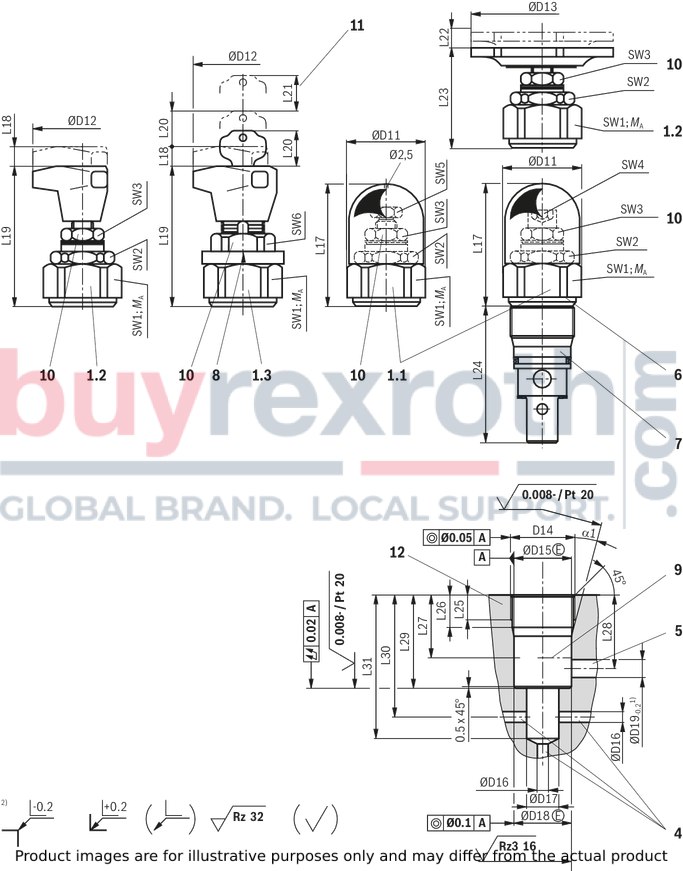
Cartridge valve
Dimensions in mm
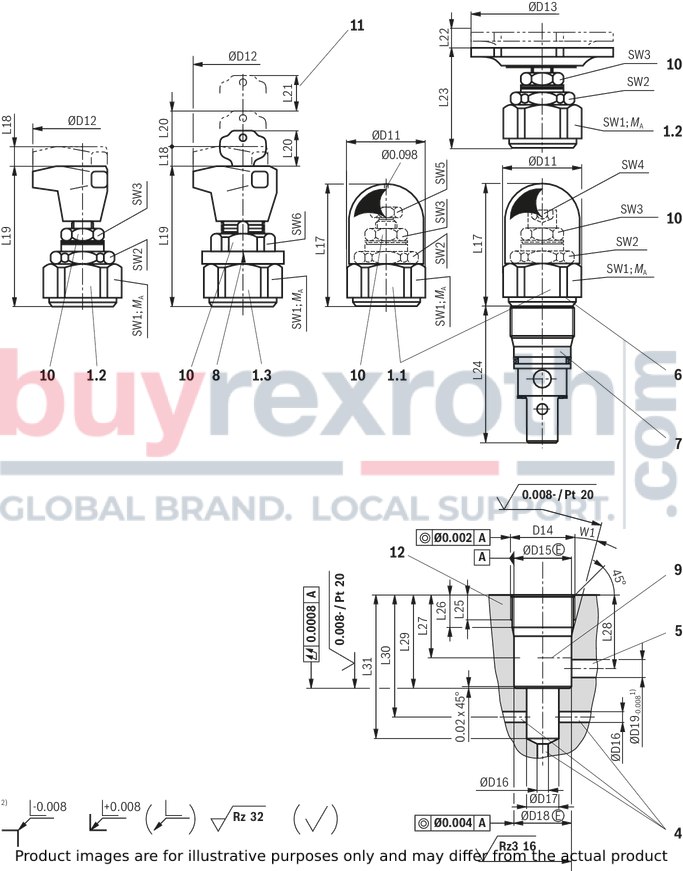
|
1.1 |
Adjustment type "S” – Grub screw with hexagon and protective cap; internal hexagon (NG6 … NG20), external hexagon (NG30) |
|
1.2 |
Adjustment type “H” – rotary knob (NG6 … NG20), hand wheel (NG30) |
|
1.3 |
Adjustment type "A” – lockable rotary knob NG6 … NG10 (NG20 …100 bar) |
|
4 |
Port P, at any place at the circumference or at the front side |
|
5 |
Port T, at any place at the circumference |
|
6 |
Type designation |
|
7 |
Pressure rating (stamped in) |
|
8 |
Marking (adjustment of the zero position after the valve has been screwed in; then fixing of the ring by horizontal shifting until it engages on the plug screw SW6). |
|
9 |
Depth of fit |
|
10 |
Lock nut, tightening torque MA = 10+5 Nm |
|
11 |
Space required to remove the key |
|
12 |
Minimum stability of the housing materials, see "Technical data". |
|
1) |
Maximum dimension |
|
2) |
All seal ring in sertion faces are rounded and free of burrs; tolerance for all angles ± 0.5° |
Cartridge valve
|
NG |
ØD11 |
ØD12 |
ØD13 |
L17 |
L18 |
L19 |
L20 |
L21 |
L22 |
L23 |
L24 |
SW1 |
SW2 |
SW3 |
SW4 |
SW5 |
SW6 |
Weight (approx.) |
|
mm |
mm |
mm |
mm |
mm |
mm |
mm |
mm |
mm |
mm |
mm |
mm |
mm |
mm |
mm |
mm |
mm |
kg |
|
| 6 | 34 | 60 | - | 72 | 11 | 83 | 28 | 20 | - | - | 64.5 | 32 | 30 | 19 | 6 | - |
30 - |
0.4 |
| 8 | - | - | - | - | - | - | - | - | - | - | - | - | - | - | - | - |
- - |
|
| 10 | 38 | 60 | - | 68 | 11 | 79 | 28 | 20 | - | - | 77 | 36 | 30 | 19 | 6 | - |
30 - |
0.5 |
| 15 | - | - | - | - | - | - | - | - | - | - | - | - | - | - | - | - |
- - |
|
| 20 | 48 | 60 | - | 65 | 11 | 77 | 28 | 20 | - | - | 106 | 46 | 36 | 19 | 6 | - |
30 - |
1 |
| 25 | - | - | - | - | - | - | - | - | - | - | - | - | - | - | - | - |
- - |
|
| 30 | 63 | - | 80 | 83 | - | - | - | - | 11 | 56 | 131 | 60 | 46 | 19 | - | 13 |
- - |
2.2 |
Tightening torques MA in Nm for screw-in cartridge valves
|
NG |
Pressure rating in bar |
||
|
Up to 200 |
Up to 400 |
Up to 630 |
|
|
6 |
50±5 |
80±5 |
‒ |
|
10 |
100±5 |
150±10 |
200±10 |
|
20 |
150±10 |
300±15 |
‒ |
|
30 |
350±20 |
500±30 |
‒ |
|
The tightening torques are guidelines with a friction coefficient μtotal = 0.12 and when using a manual torque wrench. |
|||
Mounting cavity
|
NG |
D14 |
ØD15 |
ØD16 |
ØD17 |
ØD18 |
ØD19 |
L25 |
L26 |
L27 |
L28 |
L29 |
L30 |
L31 |
α1 |
|||
|
mm |
mm |
mm |
mm |
mm |
mm |
mm |
mm |
mm |
mm |
mm |
mm |
mm |
mm |
° |
|||
| 6 | M28 x 1.5 | 25 |
H9 - |
6 | 15 | 24.9 |
+ 0.15 - 0.2 |
12 | 15 | 19 | 30 | 36 | 45 | 56.5 | ± 5.5 | 65 | 15 |
| 8 | - | - |
- - |
- | - | - |
- - |
- | - | - | - | - | - | - | - | - | - |
| 10 | M35 x 1.5 | 32 |
H9 - |
10 | 18.5 | 31.9 |
+ 0.16 - 0.2 |
15 | 18 | 23 | 35 | 41.5 | 52 | 67.5 | ± 7.5 | 80 | 15 |
| 15 | - | - |
- - |
- | - | - |
- - |
- | - | - | - | - | - | - | - | - | - |
| 20 | M45 x 1.5 | 40 |
H9 - |
20 | 24 | 39.9 |
+ 0.16 - 0.2 |
22 | 21 | 27 | 45 | 55 | 70 | 91.5 | ± 8.5 | 110 | 20 |
| 25 | - | - |
- - |
- | - | - |
- - |
- | - | - | - | - | - | - | - | - | - |
| 30 | M60 x 2 | 55 |
H9 - |
30 | 38.75 | 54.9 |
+ 0.17 - 0.2 |
34 | 23 | 29 | 45 | 63 | 84 | 113.5 | ± 11.5 | 140 | 20 |
Subplate mounting "P"
((dimensions in mm)
Subplate mounting
Dimensions in mm
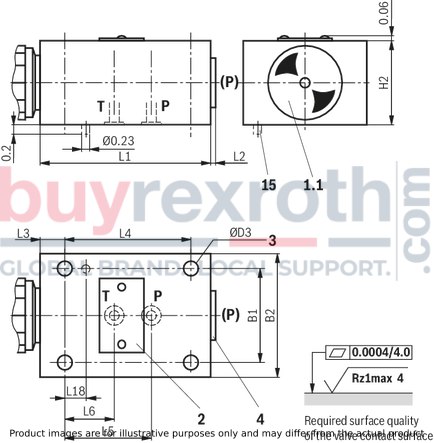
Dimensions in mm
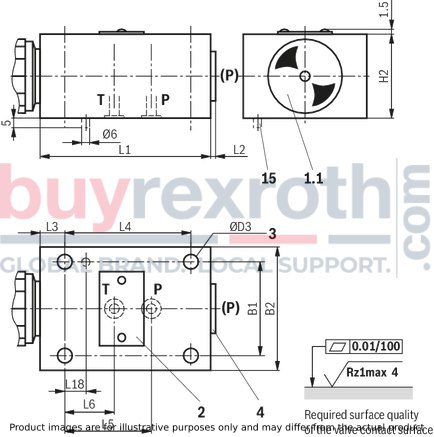
|
1.1 |
Adjustment type "S” – Grub screw with hexagon and protective cap; internal hexagon (NG6 … NG20), external hexagon (NG30) |
|
2 |
Name plate |
|
4 |
Additional port (P), optional (e.g. for pressure measurement); not possible for NG10 and pressure rating > 400 bar (= version “SO292”). Tightening torques see dimensional table) |
|
15 |
Locking pin (only with type-examination tested safety valves) |
For reasons of stability, use exclusively the following valve mounting screws (separate order):
4 hexagon socket head cap screws ISO 4762...-flZn-240h-L
(friction coefficient μtotal = 0.09 to 0.14)
|
NG |
Dimensions |
Property class |
MA in Nm 1) |
Material number |
|
6 |
M6 x 50 |
10.9 |
12,5 Nm |
R913000151 |
|
10 |
M8 x 70 |
10.9 |
28 Nm |
R913000149 |
|
20 |
M8 x 90 |
12.9 |
28 Nm |
R913000150 |
|
30 |
M10 x 110 |
12.9 |
56 Nm |
R913000148 |
| 1) | For tightening, use a manual torque wrench with a tolerance ≤10 %. |
|
NG |
B1 |
B2 |
ØD3 |
H2 |
L1 |
L2 |
L3 |
L4 |
L5 |
L6 |
L18 |
Port P |
Weight (approx.) |
|
mm |
mm |
mm |
mm |
mm |
mm |
mm |
mm |
mm |
mm |
mm |
kg |
||
| 6 | 45 | 60 | 6.6 | 40 | 80 | 4 | 15 | 55 | 40 | 20 | 15 | G1/4 | 1.5 |
| 10 | 60 | 80 | 9 | 60 | 100 | 4 | 20 | 70 | 45 | 21 | 15 | G1/2 | 3.7 |
| 20 | 70 | 100 | 9 | 70 | 135 | 5.5 | 20 | 100 | 65 | 34 | 15 | G3/4 | 6.4 |
| 30 | 100 | 130 | 11 | 90 | 180 | 5.5 | 25 | 130 | 85 | 35 | 15 | G1 1/4 | 13.9 |
Deviating dimensions: Cartridge valve as type-examination tested safety valve type DBD
(Component series 1X, according to Pressure Equipment Directive 2014/68/EU) (dimensions in mm)
Dimensions in mm
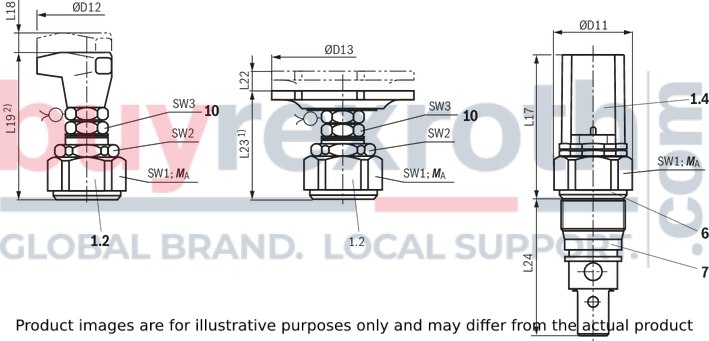
|
1.2 |
Adjustment type “H” – rotary knob (NG6 … NG20), hand wheel (NG30) |
|
1.4 |
Adjustment type "S" – hexagon with safety cap |
|
4 |
Port P, at any place at the circumference or at the front side |
|
6 |
Type designation |
|
7 |
Pressure rating (stamped in) |
|
10 |
Lock nut, tightening torque MA = 10+5 Nm |
|
1) |
Maximum dimension with lowest set response pressure |
|
2) |
The tightening torques are guidelines with a friction coefficient μtotal = 0.12 and when using a manual torque wrench. |
|
NG |
ØD11 |
ØD12 |
ØD13 |
L17 |
L18 |
L19 |
L22 |
L23 |
L24 |
SW1 |
SW2 |
SW3 |
Weight (approx.) |
|
mm |
mm |
mm |
mm |
mm |
mm |
mm |
mm |
mm |
mm |
mm |
mm |
kg |
|
| 6 | 34 | 60 | - | 80 | 11 | 83 | - | - | 64.5 | 32 | 30 | 19 | 0.4 |
| 8 | - | - | - | - | - | - | - | - | - | - | - | - | |
| 10 | 38 | 60 | - | 76 | 11 | 79 | - | - | 77 | 36 | 30 | 19 | 0.5 |
| 15 | - | - | - | - | - | - | - | - | - | - | - | - | |
| 20 | 48 | 60 | - | 73 | 11 | 77 | - | - | 106 | 46 | 36 | 19 | 1 |
| 25 | - | - | - | - | - | - | - | - | - | - | - | - | |
| 30 | 63 | - | 80 | 91 | - | - | 11 | 56 | 131 | 60 | 46 | 19 | 2.2 |
Tightening torques MA in Nm for screw-in cartridge valves
|
NG |
Pressure rating in bar |
||
|
Up to 200 |
Up to 400 |
Up to 630 |
|
|
6 |
50±5 |
80±5 |
‒ |
|
10 |
100±5 |
150±10 |
200±10 |
|
20 |
150±10 |
300±15 |
‒ |
|
30 |
350±20 |
500±30 |
‒ |
|
The tightening torques are guidelines with a friction coefficient μtotal = 0.12 and when using a manual torque wrench. |
|||
Sheet cut-out for front panel mounting with type-examination tested safety valves type DBD
(Component series 1X, according to Pressure Equipment Directive 2014/68/EU) (dimensions in mm)
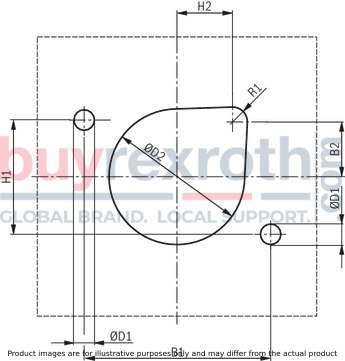
Notice:
With valves type DBDH.K..1X/..E, the hand wheel must be removed and reassembled before the front panel assembly of the screw-in cartridge valve.
Threaded connection
Dimensions in mm
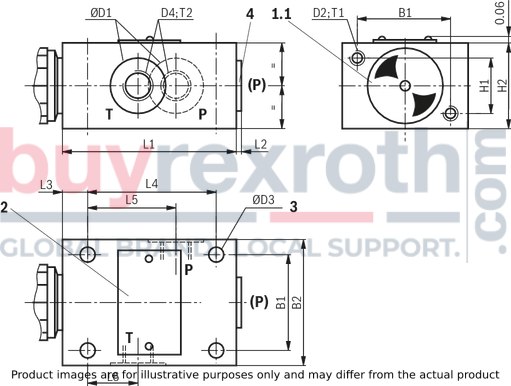
|
NG |
B1 |
B2 |
H1 |
H2 |
ØD1 |
ØD2 |
R1 |
||
|
mm |
mm |
mm |
mm |
mm |
mm |
mm |
|||
| 6 | 45 | 12.5 | 25 | 22.5 | 7 | H13 | 40 | H13 | 8 |
| 8 | |||||||||
| 10 | 60 | 20.5 | 40 | 20.5 | 9 | H13 | 44 | H13 | 8 |
| 15 | |||||||||
| 20 | 70 | 24 | 50 | 24 | 9 | H13 | 55 | H13 | 8 |
| 25 | |||||||||
| 30 | 100 | 29.5 | 60 | 29.5 | 11 | H13 | 73 | H13 | 8 |
| 2) The tightening torques are guidelines with a friction coefficientμtotal = 0.12 and when using a manual torque wrench. | |
| 1) Component series 1X, according to Pressure Equipment Directive97/23/EC | |
| 1) As replacement, you can also use specified screws according to DIN 912. | |
| 2) For tightening, use a manual torque wrench with a tolerance ≤10 %. |
Type-examination tested safety valves type DBD
(Component series 1X according to the Pressure Equipment Directive 2014/68/EU)
The functionality of these valves corresponds to that of the standard series (see "Product description"). Valves of type DBD..1X/..E are, however, type-examination tested pressure relief valves according to the Pressure Equipment Directive 2014/68/EU and intended for use as safety valves.
At the factory, the response pressure is set to a fixed maximum value using the adjustment type. Afterwards, the safety valve is sealed and/or secured using a safety cap which cannot be disassembled in non-destructive manner.
The safety valves are available with graded response pressures (in 5 bar steps). The valve version provided with a safety cap can no longer be adjusted. With valve versions equipped with rotary knob or hand wheel, the valve spring can be unloaded by the user and a response pressure lower than the factory setting can be set without the need of removing the lead seal.
Safety instructions
Before ordering a type-examination tested safety valve, it must be observed that for the desired response pressure p, the maximum admissible flowqVmax of the safety valve must be larger than the maximum possible flow of the system/accumulator to be secured. According to the Pressure Equipment Directive 2014/68/EU, the increase in the system pressure due to the flow must not exceed 10 % of the set response pressure (see component marking - ordering code, type-examination tested safety valves). The maximum admissible flow qVmax stated in the component marking must not be exceeded. Discharge lines of safety valves must end in a risk-free manner. The accumulation of fluids in the discharge system must not be possible (see data sheet AD2000 A2).It is imperative to observe the application notes!
In the plant, the response pressure specified in the component marking is set at a flow of 2 l/min. The maximum flow stated in the component marking applies for applications without counter pressure in the discharge line (port T). By removing the lead seal at the safety valve, the approval according to the Pressure Equipment Directive becomes void! Basically, the requirements of the Pressure Equipment Directive and of data sheet AD2000 A2 have to be observed! It is recommended to secure type-examination tested safety valves against inadmissible disassembly by means of wiring and sealing with the housing/block (bore available in the adjustment type).Notice:
The system pressure increases by the counter pressure in the discharge line (port T) due to the increasing flow. (Observe the data sheet AD 2000 A 2, point 6.3!)
To ensure that this increase in system pressure caused by the flow does not exceed the value of 10% of the set response pressure, the admissible flow has to be reduced dependent on the counter pressure in the discharge line (port T) (see diagrams - Safety instructions, Type-examination tested safety valves).
Related Products
R900463844
$799.00 USD
R900412315
$377.00 USD
R900438117
$527.00 USD
R900424273
$585.00 USD
R900217367
$333.00 USD

